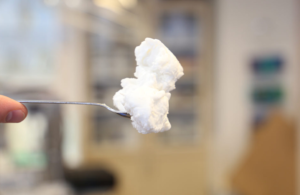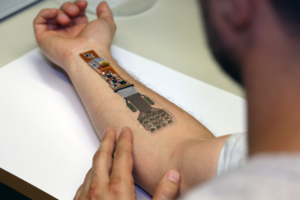 For the past two years, VTT Technical Research Centre of Finland, a top research and technology company in the Nordic countries, has been developing new bio-material applications for cellulose-based compounds for 3D printing applications to replace fossil derived raw materials. Now, the company is studying cellulose nanofibrils (nanocellulose or CNFs), which can improve bio-based 3D printing pastes as the variety and range of paste 3D printing materials is limited, for the purpose of developing a 3D wound care product to monitor the condition of patients’ wounds while in the hospital. Cellulose nanofibrils are an alternative to the chemicals, like resins, synthetic thickeners, strengtheners, and plastics, that are currently used to develop bio-based, commercial 3D printing materials.
For the past two years, VTT Technical Research Centre of Finland, a top research and technology company in the Nordic countries, has been developing new bio-material applications for cellulose-based compounds for 3D printing applications to replace fossil derived raw materials. Now, the company is studying cellulose nanofibrils (nanocellulose or CNFs), which can improve bio-based 3D printing pastes as the variety and range of paste 3D printing materials is limited, for the purpose of developing a 3D wound care product to monitor the condition of patients’ wounds while in the hospital. Cellulose nanofibrils are an alternative to the chemicals, like resins, synthetic thickeners, strengtheners, and plastics, that are currently used to develop bio-based, commercial 3D printing materials.
 Together with the University of Tampere, VTT is working to promote the growth of healthy skin cells around a wound by creating a solution where a protein attaches to a 3D printed adhesive bandage to facilitate this growth – this way, the healed area around the wound will stay flexible, instead of growing scar tissue. The Academy of Finland, under the BioDisp3D program, is funding the materials development research, which can also be used for creating indoor decorative elements and textiles. The wound care prototype combines printed electronics measuring wound healing with nanocellulose, which is a protein used in wound care.
Together with the University of Tampere, VTT is working to promote the growth of healthy skin cells around a wound by creating a solution where a protein attaches to a 3D printed adhesive bandage to facilitate this growth – this way, the healed area around the wound will stay flexible, instead of growing scar tissue. The Academy of Finland, under the BioDisp3D program, is funding the materials development research, which can also be used for creating indoor decorative elements and textiles. The wound care prototype combines printed electronics measuring wound healing with nanocellulose, which is a protein used in wound care.
Panu Lahtinen, Senior Scientist from VTT, explains, “By using nanocellulose, we have succeeded in creating 3D structures that absorb liquids three times more efficiently than the compared alginate fibre dressings commonly used in wound care.”
Silver ink was used to print the measurement electrodes, which provide connection points for VTT’s wireless FlexNode reader, onto a polyurethane-nanocellulose film; the reader, which can be attached to the patient’s wound with gauze, transmits temperature from the wound into a computer, in theory so a patient’s health care team could use it instantly. A second laminated layer of film protects the electrodes, and the 3D printed wound care gel, with active ingredients of alginate, glycerol, and nanocellulose, sits on top of that.
3D printing technology has been used for wound care applications before, but nanocellulose has not been approved for medical use yet, so it will likely be a few years before you see VTT’s work being used in hospitals. So with that in mind, the company, under the Tekes-funded DWoc and NoMA projects, while continuing to develop the material for wound care, is also working on bioprinting materials for modifying textiles, mock-ups, and indoor decoration elements.
- Nanocellulose material
Nanocellulose, or CNF, allows for new surface patterns to be created in decorative elements, and it’s possible to print separate structures that are flexible, porous, and rigid, just by choosing the appropriate material combinations. This material is manufactured from cellulose, or the side streams of food and agricultural production, and is great for 3D printing pastes, which have some unique issues, due to their mechanical strength and effects on biodegradability and viscosity. CNFs allow for 3D structures to have improved rigidity, thanks to the way the fibrils are cross-linked. Additionally, the material has an excellent capacity for water absorption, so it can be used to print pastes, which must contain that are “viscous enough for the 3D printing process.”
Last year, VTT submitted a patent application for its 3D printing materials work, and published a research paper on the work in the ACS Applied Materials & Interfaces journal.
Discuss this story and other 3D printing topics at 3DPB.com, or share your comments below.
[Source: EurekAlert / Images: VTT]
Subscribe to Our Email Newsletter
Stay up-to-date on all the latest news from the 3D printing industry and receive information and offers from third party vendors.
Print Services
Upload your 3D Models and get them printed quickly and efficiently.
You May Also Like
Making Space: Stratasys Global Director of Aerospace & Defense Conrad Smith Discusses the Space Supply Chain Council
Of all the many verticals that have been significant additive manufacturing (AM) adopters, few have been more deeply influenced by the incorporation of AM into their workflows than the space...
EOS in India: AM’s Rising Star
EOS is doubling down on India. With a growing base of aerospace startups, new government policies, and a massive engineering workforce, India is quickly becoming one of the most important...
PostProcess CEO on Why the “Dirty Little Secret” of 3D Printing Can’t Be Ignored Anymore
If you’ve ever peeked behind the scenes of a 3D printing lab, you might have caught a glimpse of the post-processing room; maybe it’s messy, maybe hidden behind a mysterious...
Stratasys & Automation Intelligence Open North American Tooling Center in Flint
Stratasys has opened the North American Stratasys Tooling Center (NASTC) in Flint, Michigan, together with automation integrator and software firm Automation Intelligence. Stratasys wants the new center to help reduce...




































